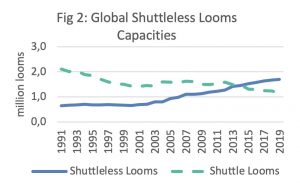ITMF ; International Textile Manufacturer Federation has published its report on International Textile Industry Statistics (ITIS) on productive capacity and raw materials consumption in the short-staple organized (spinning mill-) sector in virtually all textile-producing countries in the world.
The 2019 data shows a decrease in short-staple spindles and open-end rotors capacities around the world (see Fig. 1).
The number of installed short-staple spindles went down from 230 million.
in 2018 to 223 million in 2019. The number of installed open-end rotors decreased from 8.2 million in 2018 to 7.4 million in 2019.
These changes are mainly driven by scraping of outdated machinery in China. The trends observed in other regions are stable. The number of installed air-jet spindles is increasing worldwide, mainly in Asian countries and Turkey.

The substitution between shuttle and shuttle-less looms continues but the growth in shuttle-less looms capacities has slowed down (see Fig. 2). The number of installed shuttle-less looms increased by 1% in 2019 and reached 1.7 million units.
Total raw material consumption in the short-staple organized sector has stagnated in 2019 (see Fig. 3). Consumption of cellulosic short-staple fiber increased by 9% to 5.4 million tons and consumption of synthetic short-staple fibers decreased by -4% to 14.2 million tons. The consumption of cotton has stabilized at 26 mill tones.



























